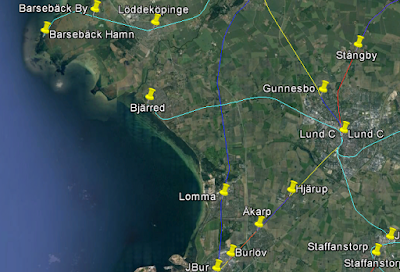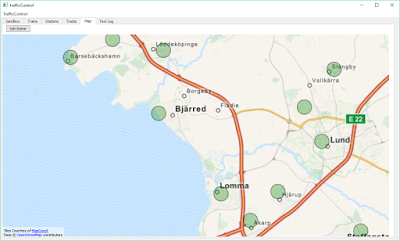For the network file "Network_LundSuburb-ThreeTrains", the program seems to work. The three trains follow their travel plans.
- Hedy_Lamarr shall start in Hjärup -> Lund -> Gunnesbo -> Lund -> Stangby (STOP)
- Ada_Lovelace shall start in Gunnesbo->Lund -> Stångby (STOP)
- Marie_Curie shall start in Lund -> Gunnesbo -> Lund (STOP)
| Time | Hedy_Lamarr | Ada_Lovelace | Marie_Curie | Comment |
|---|---|---|---|---|
| 0 | Hjärup | Gunnesbo | Lund | |
| 1 | HjaLunN | GunLunS | LunGunN | |
| 2 | HjaLunN | Lund | Gunnesbo | |
| 3 | HjaLunN | LunStaN | GunLunS | |
| 4 | Lund | LunStaN | GunLunS | |
| 5 | LunGunN | LunStaN | LunGunS | |
| 6 | LunGunN | LunStaN | Lund (Stop) | |
| 7 | Gunnesbo | LunStaN | Lund (Stop) | |
| 8 | LunGunS | Stangby (Stop) | Lund (Stop) | |
| 9 | Lund | Stangby (Stop) | Lund (Stop) | |
| 10 | LunStaN | Stangby (Stop) | Lund (Stop) | |
| 11 | Stangby (Stop) | Stangby (Stop) | Lund (Stop) | Expected behavior |
When using a network file with tracks in both directions, (Lund_Coordinates.txt), the program warns that it can't add tracs to Travel Plans:
INFO : Adding track to trainroute << Need to print what station to add. The first station (LundC) was added!
INFO : "Hedy_Lamarr" has 100 seats. 0 are taken.
: Train is at station "Hjaerup"
: TrainRoute, index: 0 :
2 : "Lund_C"
^ Current ^
ERROR : Train::addTrackToTrainRoute Error: negative number specified. <<Why wasn't the program able to addGunnesbo?
: Train is at station "Hjaerup"
: TrainRoute, index: 0 :
2 : "Lund_C"
^ Current ^
INFO : Adding track to trainroute <<This time, LundC was added to travelPlan. The program isn't designed to handle two consecutive entries of the same station in TravelPlan
INFO : "Hedy_Lamarr" has 100 seats. 0 are taken.
: Train is at station "Hjaerup"
: TrainRoute, index: 0 :
2 : "Lund_C"
^ Current ^
2 : "Lund_C"<< Hjaerup should have been before LundC in the travelPlan
INFO : Adding track to trainroute << Staangby was added to travelPlan
INFO : "Hedy_Lamarr" has 100 seats. 0 are taken.
: Train is at station "Hjaerup"
: TrainRoute, index: 0 :
2 : "Lund_C"
^ Current ^
2 : "Lund_C"
3 : "Staangby"
In the next blog post, I'll add extra prints to show what happens when trying to add Gunnesbo station to travel plans.





